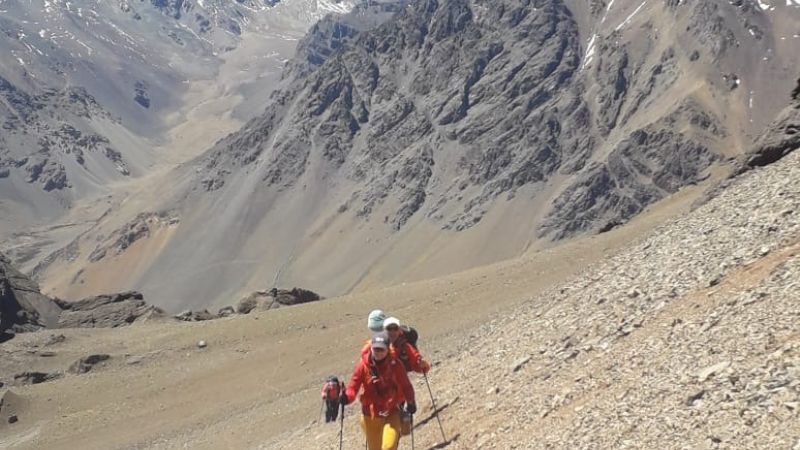ACONCAGUA II NEWS….

There’s nothing we enjoy more than seeing photos roll in of groups having tonnes of fun on an expedition! These latests photos speak for themselves! Our group are in the stunning area of las Cuevas, close to the border with Chile.
No matter the route you have chosen, the first few days of the expedition will be the same. On the first day of either trip, a guide will meet you at the airport to escort you to the first hotel in Mendoza. The second day will be a travel day to get us to Penitentes and the following day will put us near the border of Chile at a small mountain refuge.
The Las Cuevas Refuge will serve as a base for your initial acclimation process. It sits at 10,499 ft (3,200 m) and the area hikes we complete will bring us to 12,795 ft (3,900 m). The few days spent hiking around the refuge will prepare you for the time at base camp and as you climb the mountain. There will also be plenty of time to acclimate at the base camp before the summit attempt as well.
What about the Packing List for this trip?
Personal gear is not included in the cost of the expedition with Benegas Brothers so you will have to research and prepare properly ahead of time.
Although the mountain gets quite cold, it is still a rather dry climate. That doesn’t mean that you shouldn’t be accounting for the possibility of wet conditions though. There is a lot to consider when climbing Aconcagua and it won’t be done in one swift push. There will be three distinct sections to your journey: the trek in, the climb to high camp, and the summit. Don’t forget that you will also have some time in town at hotels and you will also want to account for possible travels after your climb.
So, our packing list will not be a complete guide and some options may not work for everyone. These are simply the clothing and gear recommended for a successful journey.
Clothing should be high-quality wicking material (merino wool or polyester) as to not retain moisture. This means that standard cotton will not suffice. All listed clothing options are recommended as layering is a key component in successful temperature regulation.
- Breathable Underwear 6-10 pairs
- Trekking Socks 6-8 pairs
- Lightweight Long-sleeve Shirts 1-3
- Trekking Pants
- Thermal Base Layer (shirt and pants)
- Fleece Jacket
- Hard Shell Jacket
- Hardshell Trousers
- Insulated Jacket
- Sun Hat
- Neck Gaiter or Bandana
- Warm Fleece Beanie
- Thermal Balaclava
- High Altitude Sunglasses
- Snow Goggles
- Inner and Outer Gloves
- Mittens
- Hiking Boots
- High Altitude Mountaineering Boots
While what you wear is an extremely important aspect of the packing list, there are still a number of other vital gear requirements:
- Backpack 85-105 L
- Duffle Bag (for additional items you aren’t taking on the mountain)
- Sleeping Bag (-22F/-30C)
- Sleeping Pad
- Trekking Poles
- Water Bottle / Hydration Bladder
- Headlamp
- Toiletries (Necessities stored in a dry bag)
- Sunscreen and Lip Balm
- Personal First Aid Kit
- Medications
- Baby Wipes
- Hand / Toe Warmers
- Additional Snacks
Other Additional Items to Consider:
Depending on the route, you may need to take climbing gear such as a helmet, ice axe, and crampons.
- Some climbers enjoy reading in their downtime and bring a book or even journal
- Camera
- Pee Bottle / Funnel for cold nights near the summit
- Ear Plugs if you’re sharing a tent
- Conditioning
Being physically prepared is a necessary component in Aconcagua summit success. Most climbers devote at least 5-6 months of training and conditioning in preparation for their trek up the mountain. Proper conditioning for Aconcagua will include building up your strength, stamina, and endurance.
Conditioning for this trek, climbing and hiking are the best tools and activities as you prepare. You can plan some weekend trips to include long backpacking treks or even nightly hikes up peaks nearby. Since you may not be able to do that daily, you will need to include other cardio options like running, cycling, skiing, or even fast walking.
Since you will be carrying a pack for some of the trips, it will be helpful to train with weight as well. You can easily do this by taking a loaded pack on a day hike or as mentioned earlier, take a few backpacking trips. This gives you a great chance to test out some of your gear as well.
Alongside the cardio, you will want to throw in some strength training to improve and maintain your anaerobic metabolism. When you are conditioning for a mountain trek, it isn’t as important to be using heavy weights, instead, you should focus on lighter weights with more repetitions. This also helps you to focus on your form to avoid injury.
Exercise isn’t the only important aspect of conditioning that should be considered before your trek. Keep your mind and body healthy by eating well, drinking plenty of water, and practice mindfulness activities to refocus when things get tough.
If you are taking the Polish Glacier route, you will need to be an experienced climber. This technical route requires conditioning with a focus on ice climbing endurance and mental fortitude. There will be specific skills required that you are familiar with in order to be accepted for this trekking option and it is best to practice these skills often.